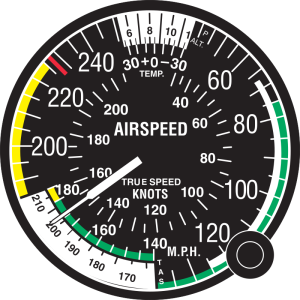
Are you familiar with the different types of airspeed? While cars, trucks and other vehicles on the road typically have a single speed metric, airplanes have several speed metrics. They include indicated airspeed (AIS), true airspeed (TAS) and ground speed (GS).
#1) IAS
When flying an airplane, pilots will see the IAS displayed on the airspeed indicator. It’s the single most common type of airspeed. IAS represents the dynamic pressure of the air generated by the airplane’s forward motion.
The airplane’s altitude will affect its IAS. As the airplane ascends, its IAS will decrease because of the reduction in air density.
#2) TAS
TAS represents the speed at which an airplane is flying relative to the surrounding air mass. Pilots use it to calculate expected flight times. The higher the TAS, the sooner the airplane will arrive at its destination.
TAS takes into account the altitude of the airplane and the temperature of the surrounding air. These factors will affect the airplane’s TAS.
#3) GS
The third type of airspeed is GS. GS is similar to TAS. The difference is that TS represents the speed of an airplane relative to the surrounding air mass, whereas GS represents the speed of an airplane relative to the ground.
GS takes into account wind, such as headwinds and tailwinds, as well as the airplane’s true speed. Pilots use it to calculate expected flight times as well as fuel consumption and efficiency.
Airspeed Indicators
There are airspeed indicators in the cockpit that provide pilots with information about the speed of the airplane. Also known as airspeed gauges, they are essential flight instruments.
Most airspeed indicators are color coded. The green portion of an airspeed indicator indicates normal operating range. The yellow portion of an airspeed indicator indicates caution. The red portion of an airspeed indicator, on the other hand, indicates danger. Regardless, pilots can monitor the airspeed indicators in the cockpit to measure airspeed-related metrics like AIS, TAS and GS. Airplanes often have multiple airspeed indicators for AIS, TAS and GS.
In Conclusion
Airplanes don’t have a single speed metric. There are three primary types of airspeed: AIS, TAS and GS. AIS is the dynamic pressure of the air generated by an airplane’s forward motion. TAS is the speed at which an airplane is flying relative to the surrounding air mass. And GS is the speed of an airplane relative to the ground.



